Why Hyper-Casual Games Are the Best to Start Raising Profit in Mobile Game Development?

The mobile market is measured in hundreds of billions of dollars. A significant niche of this business is occupied by the mobile games industry, with expected values to exceed $91.2 billion by 2021.
One of the crucial things a game developer’s success depends on is choosing the type of game that fits their target audience and budget.
And then the issue arises whether you should create some hyper-casual or the complex one. Although both types have their advantages and drawbacks, we believe it is better to start with hyper-casual games instead of a complex game.
Here’s What We’ll Cover
What Are the Hyper-Casual Games?
Hyper-casual games are lightweight mobile games that offer instant gameplay and apply basic mechanics. These games usually have a single mechanic and a minimalistic interface.
Hyper-casual games take up less space on a player’s device, thus making them handier and less likely to be uninstalled. Hyper-casual games are designed to be played over several short sessions so users can instantly tap to play or to stop.
All of these things make a hyper-casual game highly addictive and engaging.
Hyper-Casual Game Design
Players are looking for a short, straightforward, and enjoyable gaming experience. As such, hyper-casual games should involve smooth designs with clear visuals and simple UI.
Most hyper-casual games apply basic geometry, lines, characters, or backgrounds. But note, replicating trends does not mean you should fully copy an existing game. Plagiarism will be taken offline by app stores. Moreover, this solution will have a negative effect on your brand reputation.
In addition to clear visuals, many hyper-casual games are focused on a single, easy-to-understand, and engaging core mechanic. Though some games have more than one. At the same time, it should be mentioned that the range of hyper-casual game mechanics to choose from is quite wide.
Mechanics for Hyper-Casual Games
Tap / Timing Mechanics
Tap and Timing mechanic relies upon an exact tap or exact timing. Timing games all come down to tapping the screen at that perfect moment. Precision is the most important aspect of the action. For instance, you’ll need to time your jumps or when you hit the ball. If you miss your chance, you’ll need to wait again for the perfect moment. Voodoo’s Baseball Boy! is an excellent example of tap/timing mechanics.
Other mechanics also use tapping or timing elements as an input method for their particular gameplay.
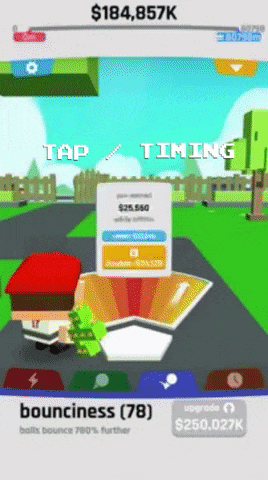
Turning Mechanics
The turning mechanic adds a complication to each tap by adding a confusing visual perception. The player controls a character and manages when to move left or right. As these games are usually 3D, the turning is normally a fixed value.
Great examples are driving games like in Skiddy Car by Kwalee, where the player drives a car turning from left to right along a track.

Agility or Dexterity Mechanics
Dexterity games shouldn’t be confused with timing games. The difference is that the timing games are about tapping the screen at the right time, agility mechanics are about repeating a motion. For example, the player could be alternating from swiping left to swiping right in rapid succession.
These mechanics are well shown in the game Tiles Hop: EDM Rush!, when the player should bounce along with the pads.

Rising / Falling Mechanics
In the rising and falling games, the constant progression of the level leads to the feeling of progression without a change in the mechanic or goal. Helix Jump by Voodoo shows how progression develops as you traverse up or down the game.
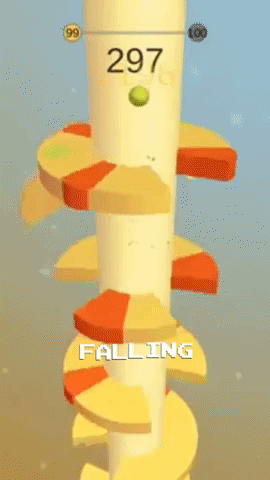
Swerving Mechanics
These swerve mechanic games focus on a player’s accuracy of input from dragging and sweeping a finger, rather than timing a tap. These mechanics became more popular with the release of Color Bump, published by Good Job Games and Aquapark by Voodoo. The purpose of these games is to avoid barriers by moving an object left and right.
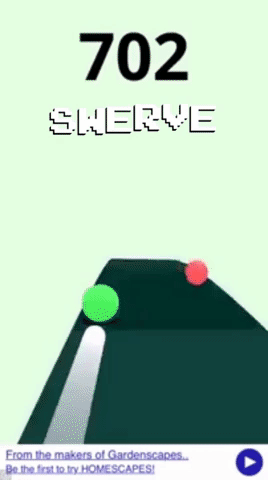
Merging Mechanics
A merging mechanic’s goal is to find similar objects and use them to create something more valuable. As an example, you may consider immortal Snake or the Merge Dogs game, where players can merge two dogs into a more valuable breed
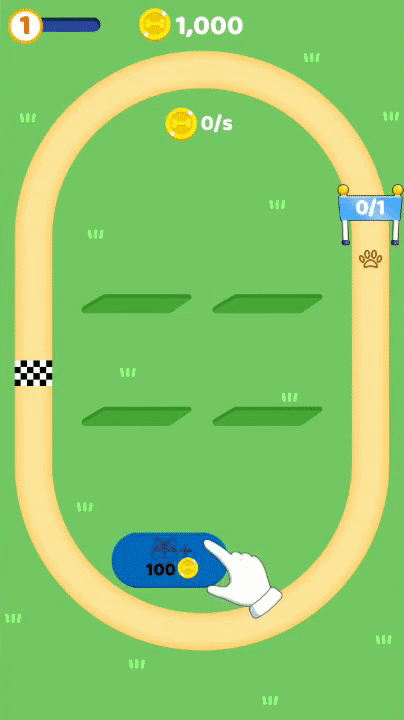
Idle Mechanics
At its core, the idle mechanic is any mechanic that doesn’t require input from a player to progress. No input at all is a very casual experience, but also one that without a goal becomes boring. Most of the time idle mechanics form a secondary mechanic attached to a soft currency.
Adventure Capitalist by Hyper Hippo made the idle mechanic the core focus of the gameplay and built a game around repeating the mechanic with different growth rates.
It became successful because of the interplay between the rates and the addition of ascension mechanics which force a player to lose all their progress in the current game to increase the speed of progress in the next game.

Growing Mechanics
Growing mechanics are usually independent of the core control input but do form the core gameplay objective. It’s objective is to become the largest object, whether that’s a crowd, a black hole, or a sticky ball.
A great example is Slither.io by Lowtech Studios, a multiplayer online video game. Players control a worm-avatar, which consumes multicolored pellets. The game aims to grow the longest worm on the server.

Puzzle Mechanics
Typical puzzles tend to get harder over time, usually by adding more mechanics. But the hyper-casual puzzle games focus on simplicity rather than complexity. The player needs to be able to solve it in a minute or less.
In hyper-casual puzzles, like Roller Splat! by Voodoo, 1010! By Gram Games or 2048 by Ketchap, the big key is that there isn’t a time limit. And they’re relatively straightforward puzzles, so it doesn’t take long to complete. Instead, the game removes the stress and balances out the gameplay.
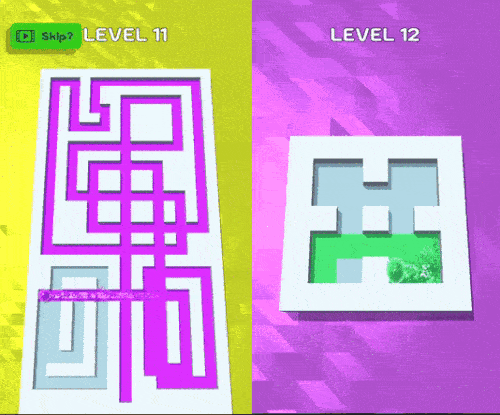
Resizing Mechanics
Resizing games are similar to swerving games, but there’s a lot more potential to branch out and create something unique. Resizing games enable players to shrink or grow an avatar, usually to fit through specific gaps.
A good example is Jelly Shift by SayGames. Players can resize a block to fit through gaps, but failing it doesn’t break the flow of the core gameplay.
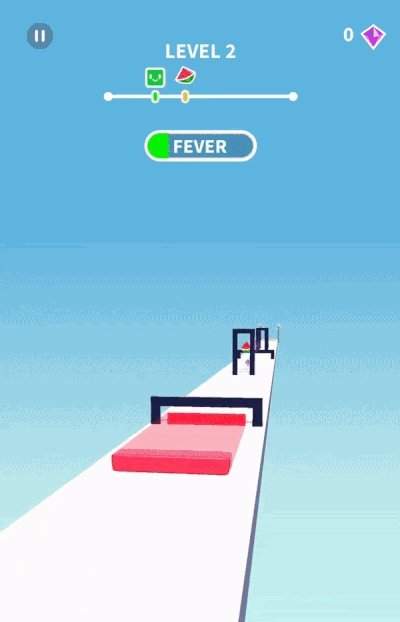
Pushing Mechanics
This game’s mechanics are usually being able to move the character and some sort of physics. A player is often involved with pushing other players or objects that come along their path. Push em all by Voodoo is a perfect example of this.
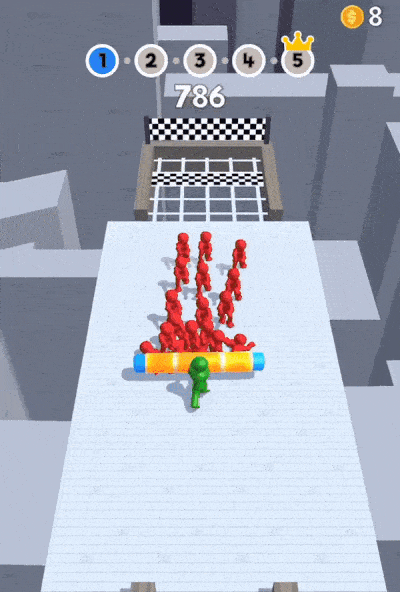
Direction Mechanics
Direction mechanics games involve applying the physics in the game to coax a tide of objects, whether they are balls or liquids, to a destination. The player is creating or removing obstacles to some sort of flow. For example, in Sand Balls by SayGames the player simply wipes away sand to give a route for the balls to the bottom of the level.

Color-Matching Mechanics
Color-matching games are often involved with matching and identifying the right colors and being able to pair them together. A popular game following such game mechanics is the snake approaching food.
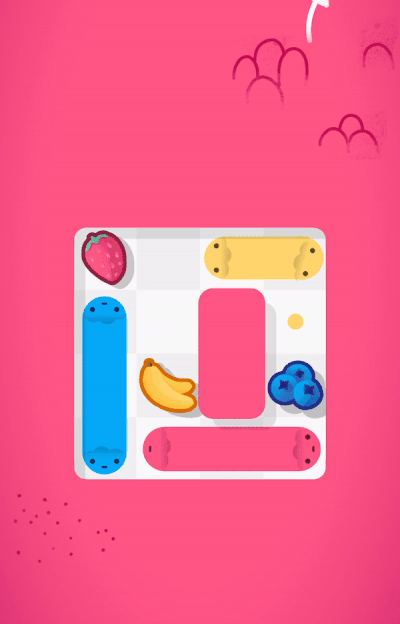
Why Is It Better to Create Multiple Hyper-Casual Games than One Complex?
Simple yet Addictive
Hyper-casual games apply clear and repetitive mechanics, which make them truly addictive. Its short sessions allow players to play a quick round or stop the game at any time.
Those games do not involve any complex tutorial. So, the player can start playing the game immediately.
A crucial thing for hyper-casuals is a low download size, which allows players to download games even on the low connection speed. Also, they don’t occupy a lot of valuable space on your device.
Infinite Gameplay
Complex games have a goal that completes the game once the player reaches it. After that, there isn’t any motivation for the player to play the game all over again.
The good hyper casual puzzle game has often no end. The levels only increase in difficulty or speed. The goal is to get the highest score or beat competitors’.
To retain and increase the user’s engagement, hyper-casual game publishers usually incorporate additional elements like upgrades, new locations, characters, or equipment. Further, a good hyper-casual game includes collecting in-game currency, which can be used for purchasing new features.
Larger Audience
While complex games appeal to loyal gamers, hyper-casual games target the mass market. Those game’s themes are familiar to different target audiences. Their convenience mechanics enable attracting a large target audience and generating revenue with a freemium monetization model.
More Monetization Options
Hyper-casual games are offered to users for free that is why their revenue mainly relies on ads. For this reason, game publishers should understand the different ads they can implement and how they will be incorporated into the user experience.
First, you need to choose an advertising format that fits with the design of the game and will increase the game’s revenue.
Below you will find the most attractive ad formats for hyper-casual games to consider:
Rewarded Video Ads
The rewarded video format is simple — reward players to watch ads. This solution allows you to increase retention and session length. For example, the reward might be something that provides players an advantage, such as in-game currency, extra lives, or moves. Then they can then use this prize to progress through the game.
OpenX marketing platform reported that 77% of users are willing to watch a 30-second ad if they are rewarded.
Banner Ads
The Liftoff mobile user acquisition firm found that banner ads are 120% more effective than video ads. Additionally, the study showed banner ads outperforming native ads when it comes to post-install engagement on Android.
Interstitial Ads
Interstitial ads are full-screen ads that cover the interface of their host app. This ad format can also include video, store locators, and even playable content. The interstitial ads are displayed at natural transition points such as between activities or levels in a game.
How Much Does It Cost to Develop a Hyper-Casual Game?
So, how much does it cost to make a hyper-casual game? This is an issue on the minds of many of our clients as well.
The cost of hyper-casual game development depends on many factors. For instance, on the number of units or the complexity of the graphics.
The total project timeline can vary from 1 to 2 months. The total cost comes out to around $10,000 minimum.
Why Have Hyper-Casual Games Taken off?
Today the hyper-casual genre has gained a high score in the marketplace, providing players with gameplay they enjoy and companies a platform to deliver successful ad campaigns. So what exactly makes these games so successful?
Hyper-casual games focused on clear graphics, simple mechanics, and light progression systems. Further, hyper-casual games replaced the in-app purchases model with advertising revenue.
It seems tricky to create a unique game, but talented startups can carve out their niche. First, you should choose a mechanic that has strong retention metrics, then work on developing or improving the specific gaming environment. Note, the game design and mechanics should be clear and simple, or your hyper-casual game will lose everything that makes it special.
If you are curious to know how to create a hyper-casual game as popular as Voodoo’s, please contact us at [email protected]. Together we will achieve it.





Steve says:
Well written, well explained.